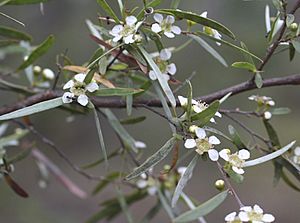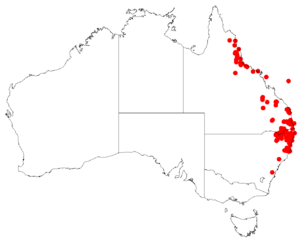Leptospermum brachyandrum facts for kids
Quick facts for kids Leptospermum brachyandrum |
|
|---|---|
 |
|
| Scientific classification | |
| Genus: |
Leptospermum
|
| Species: |
brachyandrum
|
 |
|
| Occurrence data from AVH | |
| Synonyms | |
|
|
Leptospermum brachyandrum is a type of shrub or small tree. It is found only in eastern Australia. This plant has smooth bark and long, thin leaves. It also has pretty white flowers. You can often find it growing near creeks, sometimes even in the water!
Contents
Discovering Leptospermum brachyandrum
Leptospermum brachyandrum is a shrub or small tree. It usually grows to be about 4 to 6 meters tall. Its bark is smooth and peels off in strips. When the stems are young, they are thin and very hairy.
What Does It Look Like?
The leaves of this plant are long and narrow. They are about 20 to 50 millimeters long. They are also about 2 to 4 millimeters wide. The leaves are attached directly to the stem.
The flowers grow alone or in small groups. Up to seven flowers can be found together. They grow where leaves meet the stem. Sometimes they grow at the ends of branches. Each flower is about 7 millimeters wide.
The base of the flower, called the floral cup, is mostly smooth. It is about 3 millimeters long. The sepals, which are like small leaves protecting the bud, are about 1 millimeter long. They stay on the plant as the fruit grows. The petals are white and measure 2 to 3 millimeters long. The stamens, which are the male parts of the flower, are about 1 millimeter long.
This plant usually flowers from November to January. After flowering, it produces a woody fruit. This fruit is a round capsule, about 4 millimeters wide.
How It Got Its Name
This special tea-tree was first described in 1919. A scientist named Ferdinand von Mueller gave it the name Kunzea brachyandra. He wrote about it in a science journal.
Later, in 1917, another scientist, George Claridge Druce, changed its name. He renamed it Leptospermum brachyandrum. The second part of its name, brachyandrum, comes from ancient Greek words. "Brachy" means "short" and "andrum" means "male". This refers to the stamens, which are shorter than those found in similar plants called kunzeas.
Where Does It Grow?
Leptospermum brachyandrum often grows in forests with many shrubs. It likes rocky creeks and is often found in the water. You can find this plant in areas near the coast. It grows from North Queensland all the way down to Port Macquarie in northern New South Wales.

